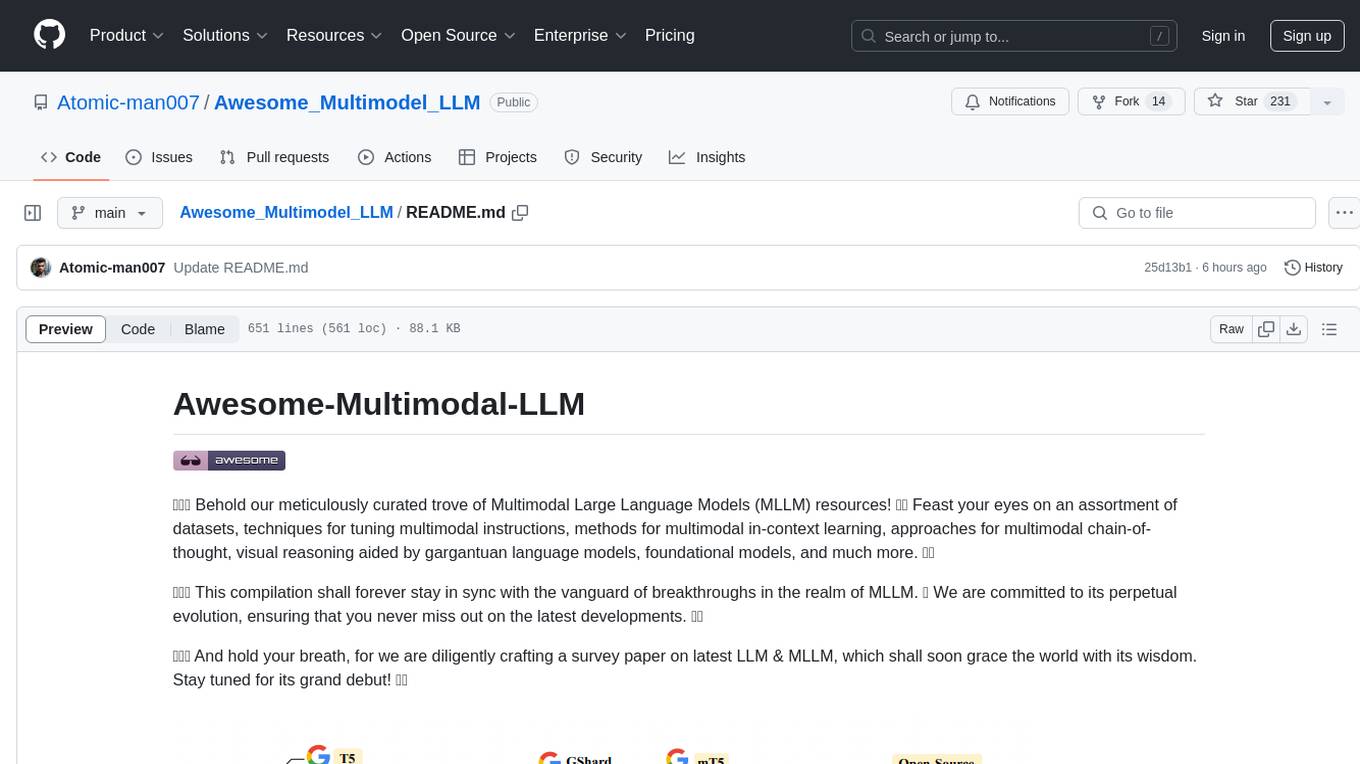
LlamaV-o1
Rethinking Step-by-step Visual Reasoning in LLMs
Stars: 215
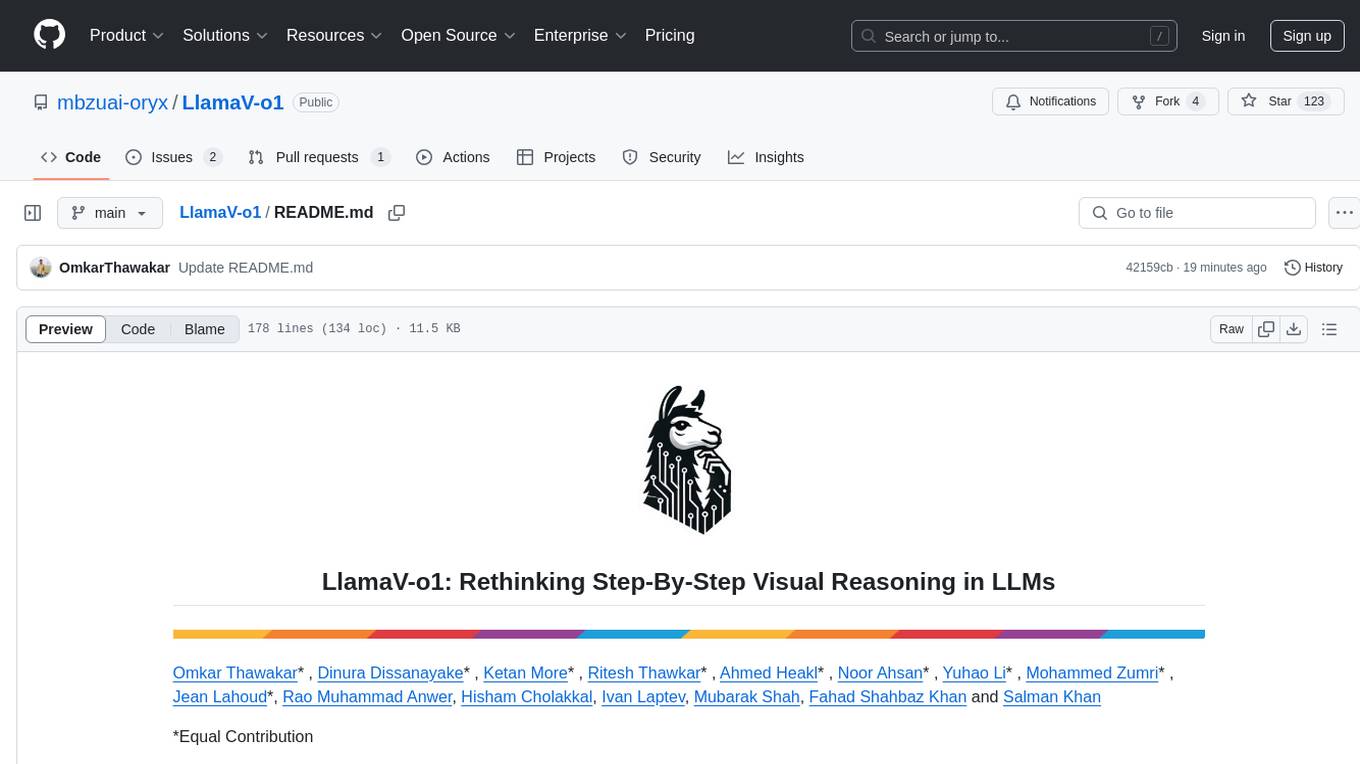
LlamaV-o1 is a Large Multimodal Model designed for spontaneous reasoning tasks. It outperforms various existing models on multimodal reasoning benchmarks. The project includes a Step-by-Step Visual Reasoning Benchmark, a novel evaluation metric, and a combined Multi-Step Curriculum Learning and Beam Search Approach. The model achieves superior performance in complex multi-step visual reasoning tasks in terms of accuracy and efficiency.
README:
Omkar Thawakar* , Dinura Dissanayake* , Ketan More* , Ritesh Thawkar* , Ahmed Heakl* , Noor Ahsan* , Yuhao Li* , Mohammed Zumri* , Jean Lahoud*, Rao Muhammad Anwer, Hisham Cholakkal, Ivan Laptev, Mubarak Shah, Fahad Shahbaz Khan and Salman Khan
*Equal Contribution
Mohamed bin Zayed University of Artificial Intelligence, UAE
- January-13-2025: Technical Report of LlamaV-o1 is released on Arxiv. Paper
- January-10-2025: *Code, Model & Dataset release. Our VCR-Bench is available at: HuggingFace. Model Checkpoint: HuggingFace. Code is available at: GitHub.🤗
LlamaV-o1 is a Large Multimodal Model capable of spontaneous reasoning.
-
Our LlamaV-o1 model outperforms Gemini-1.5-flash,GPT-4o-mini, Llama-3.2-Vision-Instruct, Mulberry, and Llava-CoT on our proposed VCR-Bench.
-
Our LlamaV-o1 model outperforms Gemini-1.5-Pro,GPT-4o-mini, Llama-3.2-Vision-Instruct, Mulberry, Llava-CoT, etc. on six challenging multimodal benchmarks (MMStar, MMBench, MMVet, MathVista, AI2D and Hallusion).
- Step-by-Step Visual Reasoning Benchmark: To the best of our knowledge, the proposed benchmark is the first effort designed to evaluate multimodal multi-step reasoning tasks across diverse topics. The proposed benchmark, named VRC-Bench, spans around eight different categories (Visual Reasoning, Math & Logic Reasoning, Social & Cultural Context, Medical Imaging (Basic Medical Science), Charts & Diagram Understanding, OCR & Document Understanding, Complex Visual Perception and Scientific Reasoning) with over 1,000 challenging samples and more than 4k reasoning steps.
- Novel Evaluation Metric: A metric that assesses the reasoning quality at the level of individual steps, emphasizing both correctness and logical coherence.
- Combined Multi-Step Curriculum Learning and Beam Search Approach: A multimodal rea- soning method, named LlamaV-o1, that combines the structured progression of curriculum learning with the efficiency of Beam Search. The proposed approach ensures incremental skill development while optimizing reasoning paths, enabling the model to be effective in complex multi-step visual reasoning tasks in terms of both accuracy and efficiency. Specifi- cally, the proposed LlamaV-o1 achieves an absolute gain of 3.8% in terms of average score across six benchmarks while being 5× faster, compared to the recent Llava-CoT.
The figure presents our benchmark structure and the comparative performance of LMMs on VRC-Bench. The dataset spans diverse domains, including mathematical & logical reasoning, scientific reasoning, visual perception, and specialized areas such as medical imaging, cultural understanding, and document OCR. It also includes tasks like chart & diagram comprehension to test real-world applications. The bar chart compares various state-of-the-art models, showcasing final answer accuracy and step-by-step reasoning performance. Our LlamaV-o1 model surpasses GPT-4o-mini, Gemini-1.5-Flash, and Llava-CoT in complex multimodal reasoning tasks, achieving superior accuracy and logical coherence.
Table 1: Comparison of models based on Final Answer accuracy and Reasoning Steps performance on the proposed VRC-Bench. The best results in each case (closed-source and open-source) are in bold. Our LlamaV-o1 achieves superior performance compared to its open-source counterpart (Llava-CoT) while also being competitive against the closed-source models.
| Model | GPT-4o | Claude-3.5 | Gemini-2.0 | Gemini-1.5 Pro | Gemini-1.5 Flash | GPT-4o Mini | Llama-3.2 Vision | Mulberry | Llava-CoT | LlamaV-o1 (Ours) |
|---|---|---|---|---|---|---|---|---|---|---|
| Final Answer | 59.28 | 61.35 | 61.16 | 61.35 | 54.99 | 56.39 | 48.40 | 51.90 | 54.09 | 56.49 |
| Reasoning Steps | 76.68 | 72.12 | 74.08 | 72.12 | 71.86 | 74.05 | 58.37 | 63.86 | 66.21 | 68.93 |
Table 2: Performance comparison on six benchmark datasets (MMStar, MMBench, MMVet, MathVista, AI2D, and Hallusion) along with average scores. The comparison includes both closed-source and open-source models. GPT-4o achieves the highest average score (71.8%) among closed-source models, while our LlamaV-o1 leads open-source models with an average score of 67.33%, surpassing Llava-CoT by 3.8%.
| Model | MMStar | MMBench | MMVet | MathVista | AI2D | Hallusion | Average |
|---|---|---|---|---|---|---|---|
| Closed-Source | |||||||
| GPT-4o-0806 | 66.0 | 82.4 | 80.8 | 62.7 | 84.7 | 54.2 | 71.8 |
| Claude3.5-Sonnet-0620 | 64.2 | 75.4 | 68.7 | 61.6 | 80.2 | 49.9 | 66.7 |
| Gemini-1.5-Pro | 56.4 | 71.5 | 71.3 | 57.7 | 79.1 | 45.6 | 63.6 |
| GPT-4o-mini-0718 | 54.9 | 76.9 | 74.6 | 52.4 | 77.8 | 46.1 | 63.8 |
| Open-Source | |||||||
| InternVL2-8B | 62.5 | 77.4 | 56.9 | 58.3 | 83.6 | 45.0 | 64.0 |
| Ovis1.5-Gemma2-9B | 58.7 | 76.3 | 50.9 | 65.6 | 84.5 | 48.2 | 64.0 |
| MiniCPM-V2.6-8B | 57.1 | 75.7 | 56.3 | 60.6 | 82.1 | 48.1 | 63.3 |
| Llama-3.2-90B-Vision-Inst | 51.1 | 76.8 | 74.1 | 58.3 | 69.5 | 44.1 | 62.3 |
| VILA-1.5-40B | 53.2 | 75.3 | 44.4 | 49.5 | 77.8 | 40.9 | 56.9 |
| Mulberry-7B | 61.3 | 75.34 | 43.9 | 57.49 | 78.95 | 54.1 | 62.78 |
| Llava-CoT | 57.6 | 75.0 | 60.3 | 54.8 | 85.7 | 47.8 | 63.5 |
| Our Models | |||||||
| Llama-3.2-11B (baseline) | 49.8 | 65.8 | 57.6 | 48.6 | 77.3 | 40.3 | 56.9 |
| LlamaV-o1 (Ours) | 59.53 | 79.89 | 65.4 | 54.4 | 81.24 | 63.51 | 67.33 |
You can download the pretrained weights of LlamaV-o1 from the Huggingface: omkarthawakar/LlamaV-o1.
You can download the VRC-Bench from the Huggingface: omkarthawakar/VRC-Bench.
You can use sample inference code provided in eval/llamav-o1.py where we show sample inference on an image with multi-step reasoning.
from transformers import MllamaForConditionalGeneration, AutoProcessor
model_id = "omkarthawakar/LlamaV-o1"
model = MllamaForConditionalGeneration.from_pretrained(
model_id,
torch_dtype=torch.bfloat16,
device_map="auto",
)
processor = AutoProcessor.from_pretrained(model_id)We used llama-recipes to finetune our LlamaV-o1.
More details about finetuning will be available soon!
To reproduce our results on VRC-Bench:
Please run following.
python eval/inference.py
python eval/get_result.py
Please make sure to put correct name/path of generated json and ChatGPT API key in eval/get_result.py
To reproduce our results on SIX Benchmark Datasets:
We used VLMEvalKit to evaluate LlamaV-o1 on six benchmark datasets.
replace the file vlmeval/vlm/llama_vision with eval/llama_vision.py
Add following line to llama_series model of vlmeval/config.py file.
'LlamaV-o1': partial(llama_vision, model_path='omkarthawakar/LlamaV-o1'),
Run the following commamd
torchrun --nproc-per-node=8 run.py --data MMStar AI2D_TEST HallusionBench MMBench_DEV_EN MMVet MathVista_MINI --model LlamaV-o1 --work-dir LlamaV-o1 --verbose
If you find this paper useful, please consider staring 🌟 this repo and citing 📑 our paper:
@misc{thawakar2025llamavo1,
title={LlamaV-o1: Rethinking Step-by-step Visual Reasoning in LLMs},
author={Omkar Thawakar and Dinura Dissanayake and Ketan More and Ritesh Thawkar and Ahmed Heakl and Noor Ahsan and Yuhao Li and Mohammed Zumri and Jean Lahoud and Rao Muhammad Anwer and Hisham Cholakkal and Ivan Laptev and Mubarak Shah and Fahad Shahbaz Khan and Salman Khan},
year={2025},
eprint={2501.06186},
archivePrefix={arXiv},
primaryClass={cs.CV},
url={https://arxiv.org/abs/2501.06186},
}
- This project is primarily distributed under the Apache 2.0 license, as specified in the LICENSE file.
- Thanks to LlaVa-CoT for their awesome work. LlaVa-CoT
- The service is provided as a research preview for non-commercial purposes only, governed by the LLAMA 3.2 Community License Agreement and the Terms of Use for data generated by OpenAI. If you encounter any potential violations, please reach out to us.
For Tasks:
Click tags to check more tools for each tasksFor Jobs:
Alternative AI tools for LlamaV-o1
Similar Open Source Tools

LlamaV-o1
LlamaV-o1 is a Large Multimodal Model designed for spontaneous reasoning tasks. It outperforms various existing models on multimodal reasoning benchmarks. The project includes a Step-by-Step Visual Reasoning Benchmark, a novel evaluation metric, and a combined Multi-Step Curriculum Learning and Beam Search Approach. The model achieves superior performance in complex multi-step visual reasoning tasks in terms of accuracy and efficiency.
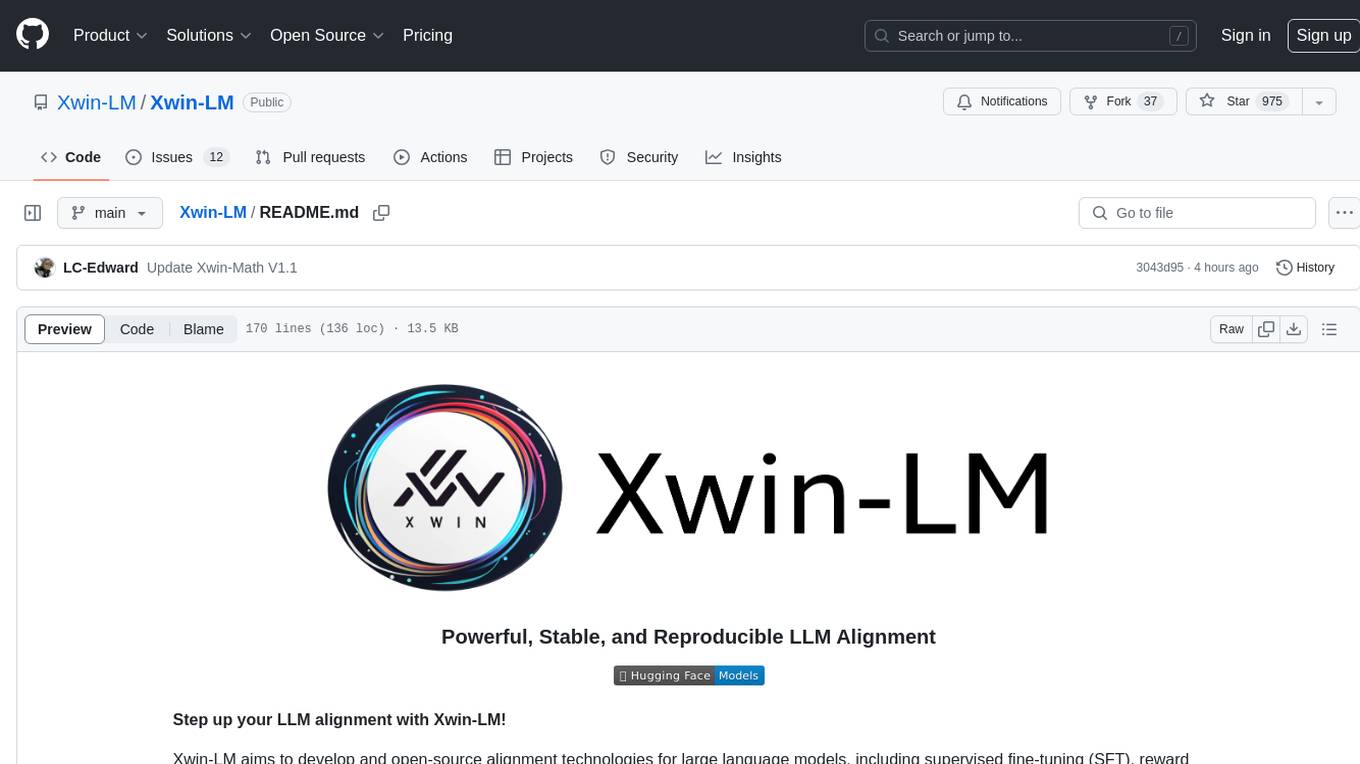
Xwin-LM
Xwin-LM is a powerful and stable open-source tool for aligning large language models, offering various alignment technologies like supervised fine-tuning, reward models, reject sampling, and reinforcement learning from human feedback. It has achieved top rankings in benchmarks like AlpacaEval and surpassed GPT-4. The tool is continuously updated with new models and features.
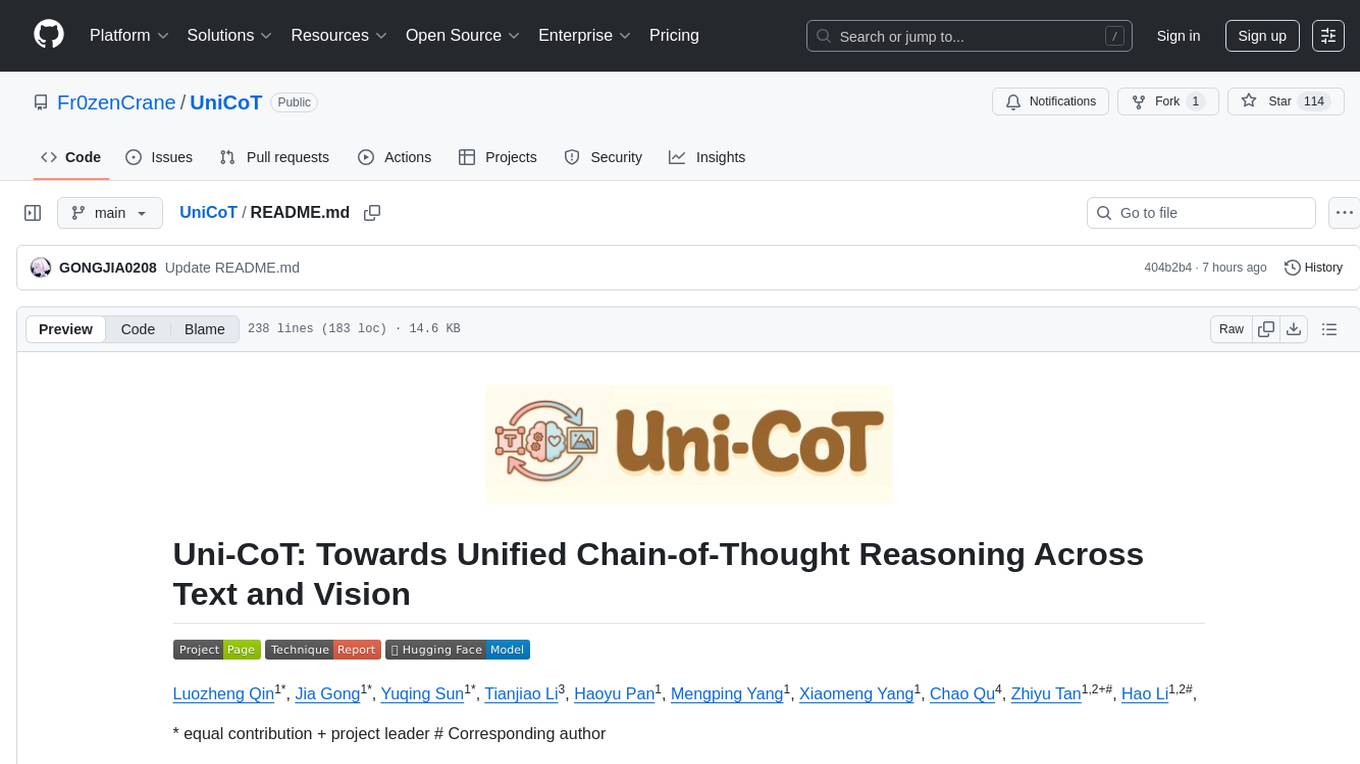
UniCoT
Uni-CoT is a unified reasoning framework that extends Chain-of-Thought (CoT) principles to the multimodal domain, enabling Multimodal Large Language Models (MLLMs) to perform interpretable, step-by-step reasoning across both text and vision. It decomposes complex multimodal tasks into structured, manageable steps that can be executed sequentially or in parallel, allowing for more scalable and systematic reasoning.
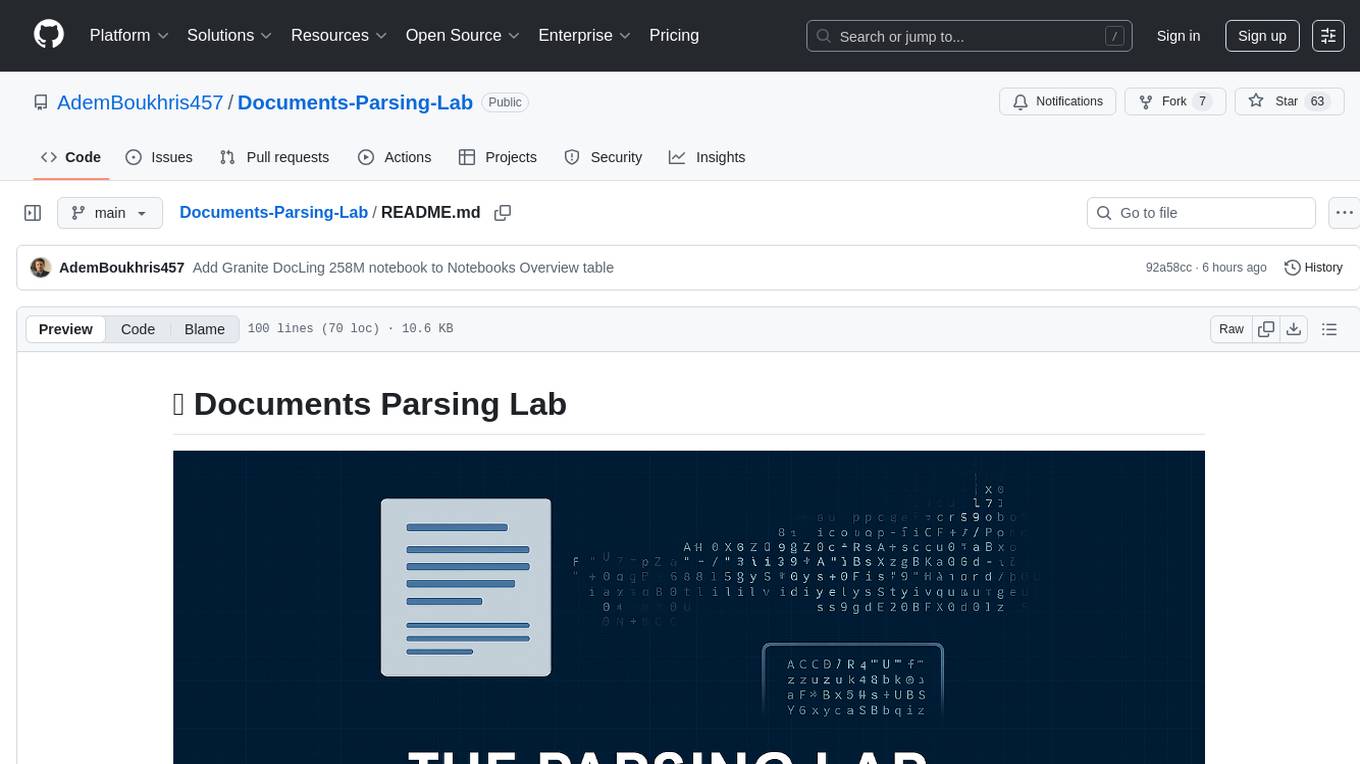
Documents-Parsing-Lab
A curated collection of Jupyter notebooks for experimenting with state-of-the-art OCR, document parsing, table extraction, and chart understanding techniques. This repository enables easy benchmarking and practical usage of the latest open-source and cloud-based solutions for document image processing.
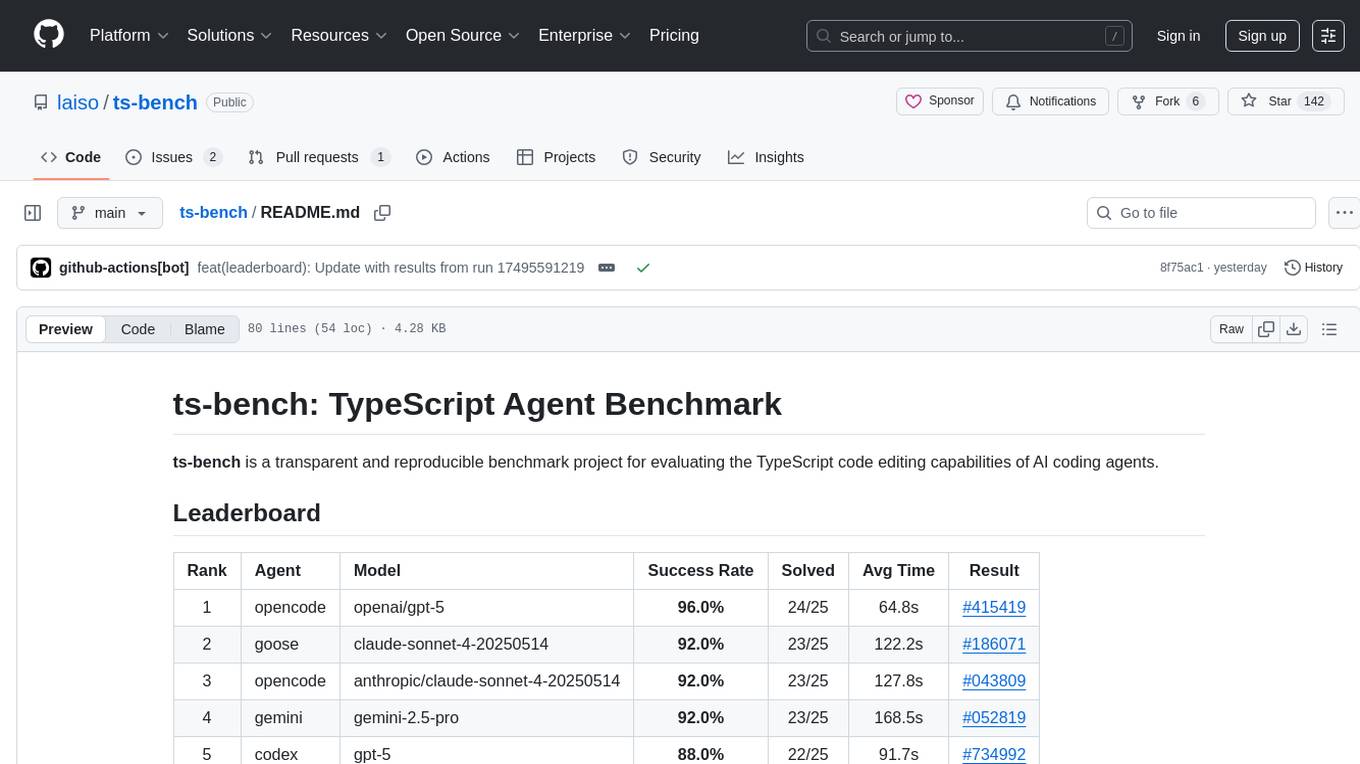
ts-bench
TS-Bench is a performance benchmarking tool for TypeScript projects. It provides detailed insights into the performance of TypeScript code, helping developers optimize their projects. With TS-Bench, users can measure and compare the execution time of different code snippets, functions, or modules. The tool offers a user-friendly interface for running benchmarks and analyzing the results. TS-Bench is a valuable asset for developers looking to enhance the performance of their TypeScript applications.
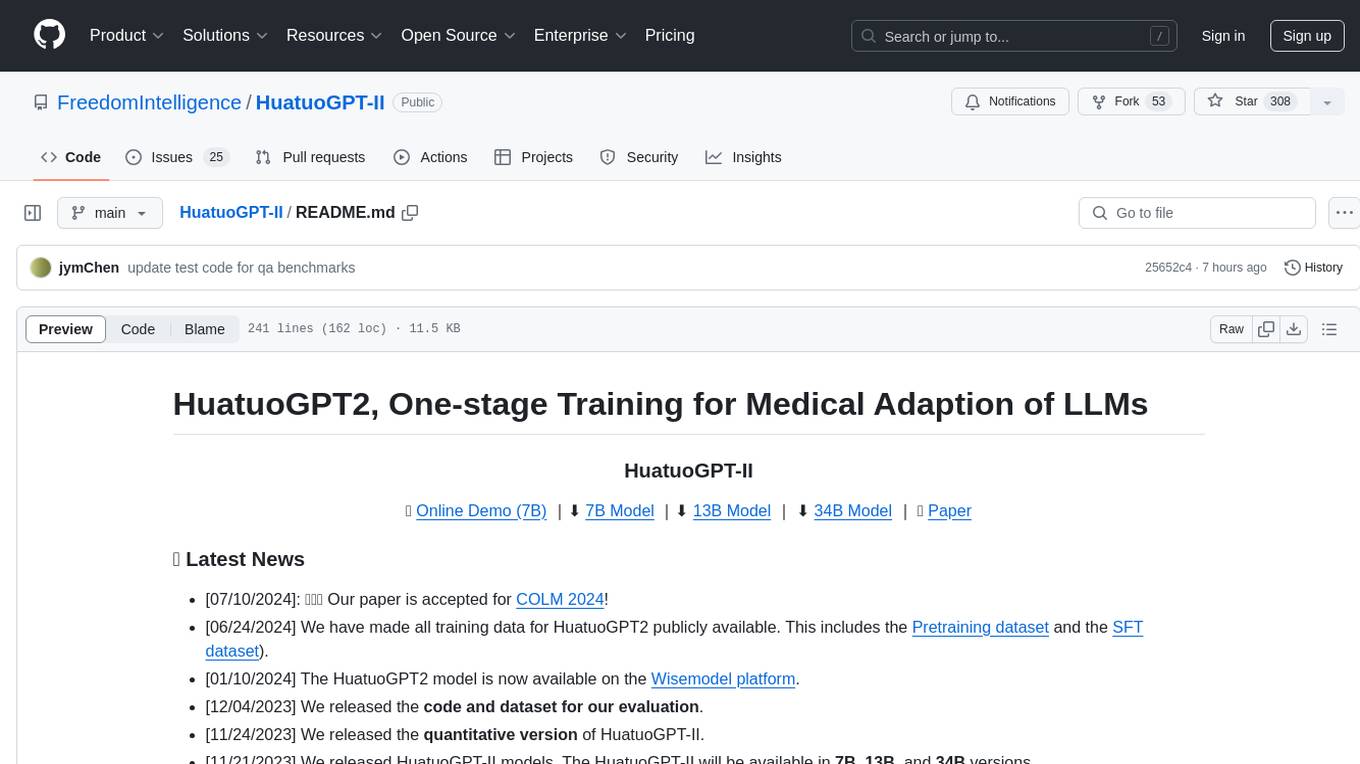
HuatuoGPT-II
HuatuoGPT2 is an innovative domain-adapted medical large language model that excels in medical knowledge and dialogue proficiency. It showcases state-of-the-art performance in various medical benchmarks, surpassing GPT-4 in expert evaluations and fresh medical licensing exams. The open-source release includes HuatuoGPT2 models in 7B, 13B, and 34B versions, training code for one-stage adaptation, partial pre-training and fine-tuning instructions, and evaluation methods for medical response capabilities and professional pharmacist exams. The tool aims to enhance LLM capabilities in the Chinese medical field through open-source principles.
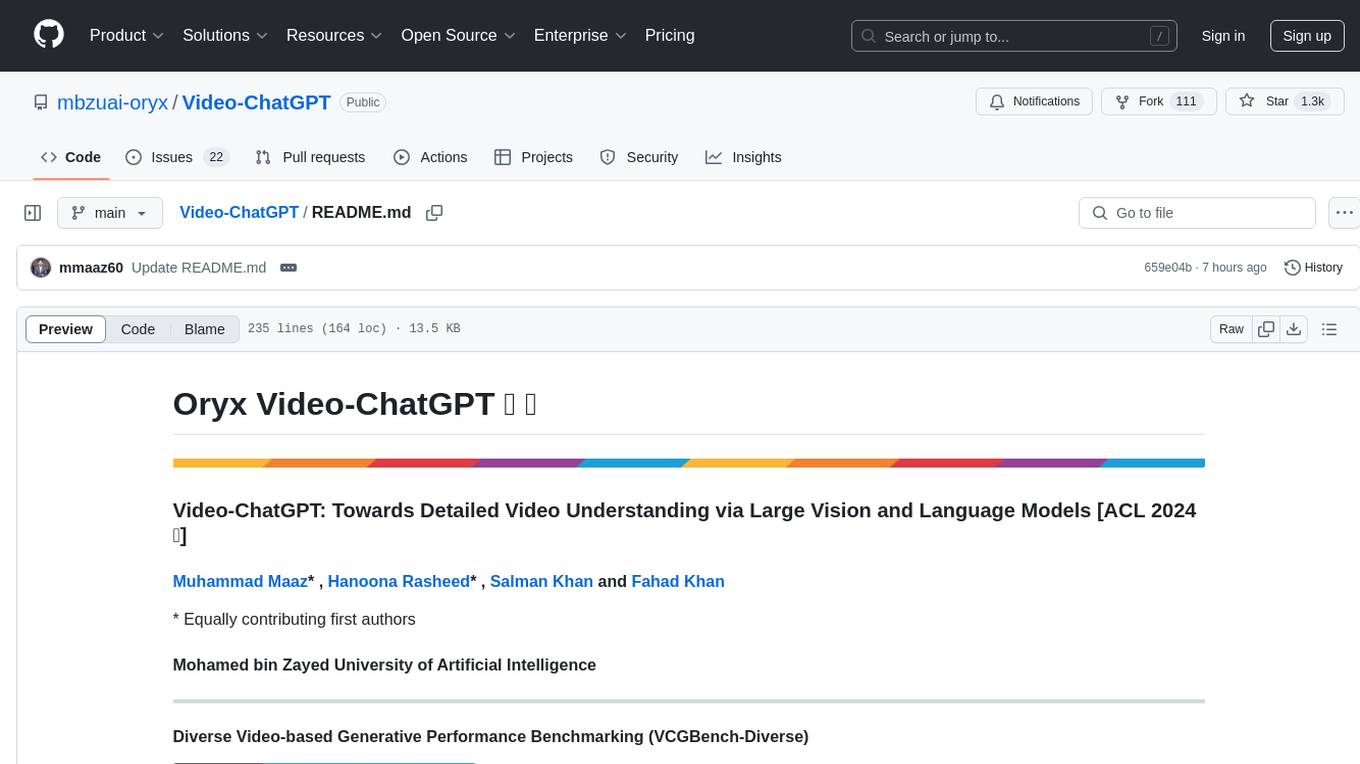
Video-ChatGPT
Video-ChatGPT is a video conversation model that aims to generate meaningful conversations about videos by combining large language models with a pretrained visual encoder adapted for spatiotemporal video representation. It introduces high-quality video-instruction pairs, a quantitative evaluation framework for video conversation models, and a unique multimodal capability for video understanding and language generation. The tool is designed to excel in tasks related to video reasoning, creativity, spatial and temporal understanding, and action recognition.
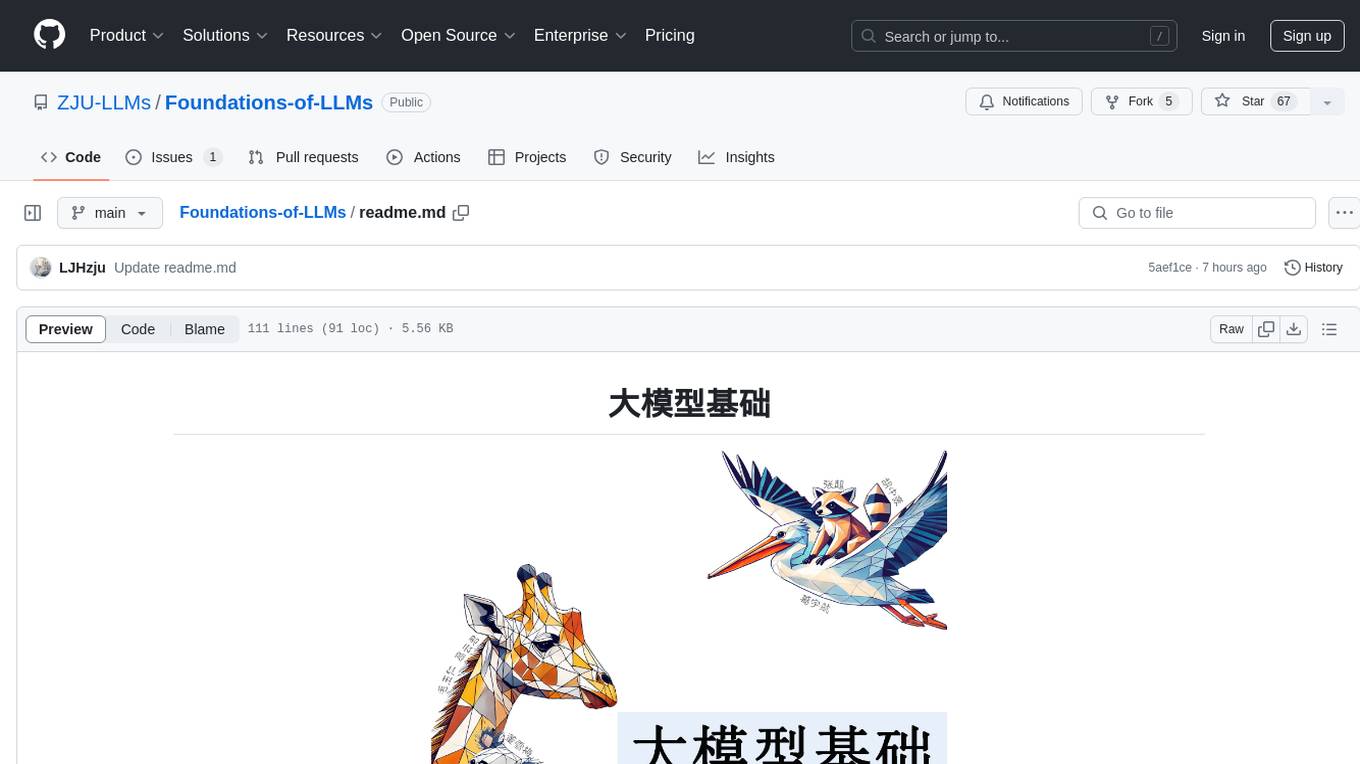
Foundations-of-LLMs
Foundations-of-LLMs is a comprehensive book aimed at readers interested in large language models, providing systematic explanations of foundational knowledge and introducing cutting-edge technologies. The book covers traditional language models, evolution of large language model architectures, prompt engineering, parameter-efficient fine-tuning, model editing, and retrieval-enhanced generation. Each chapter uses an animal as a theme to explain specific technologies, enhancing readability. The content is based on the author team's exploration and understanding of the field, with continuous monthly updates planned. The book includes a 'Paper List' for each chapter to track the latest advancements in related technologies.
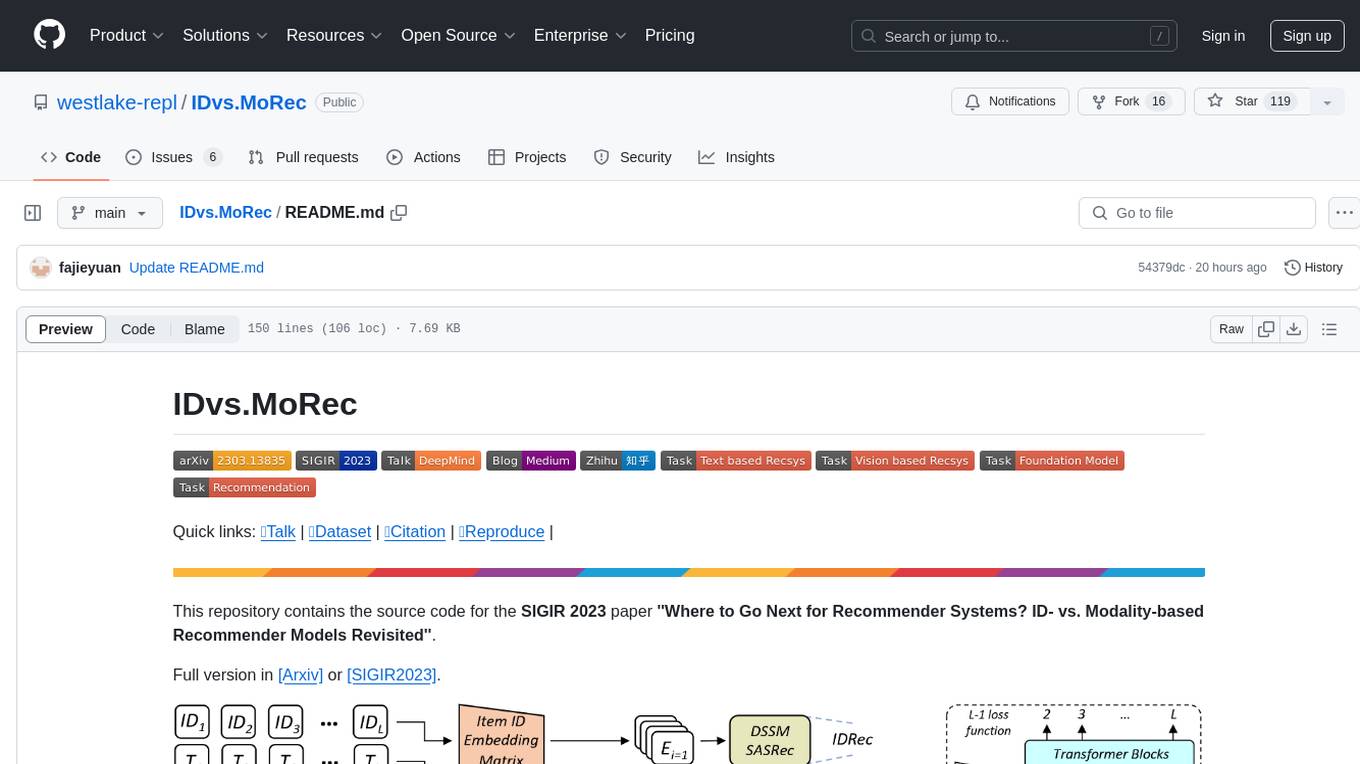
IDvs.MoRec
This repository contains the source code for the SIGIR 2023 paper 'Where to Go Next for Recommender Systems? ID- vs. Modality-based Recommender Models Revisited'. It provides resources for evaluating foundation, transferable, multi-modal, and LLM recommendation models, along with datasets, pre-trained models, and training strategies for IDRec and MoRec using in-batch debiased cross-entropy loss. The repository also offers large-scale datasets, code for SASRec with in-batch debias cross-entropy loss, and information on joining the lab for research opportunities.
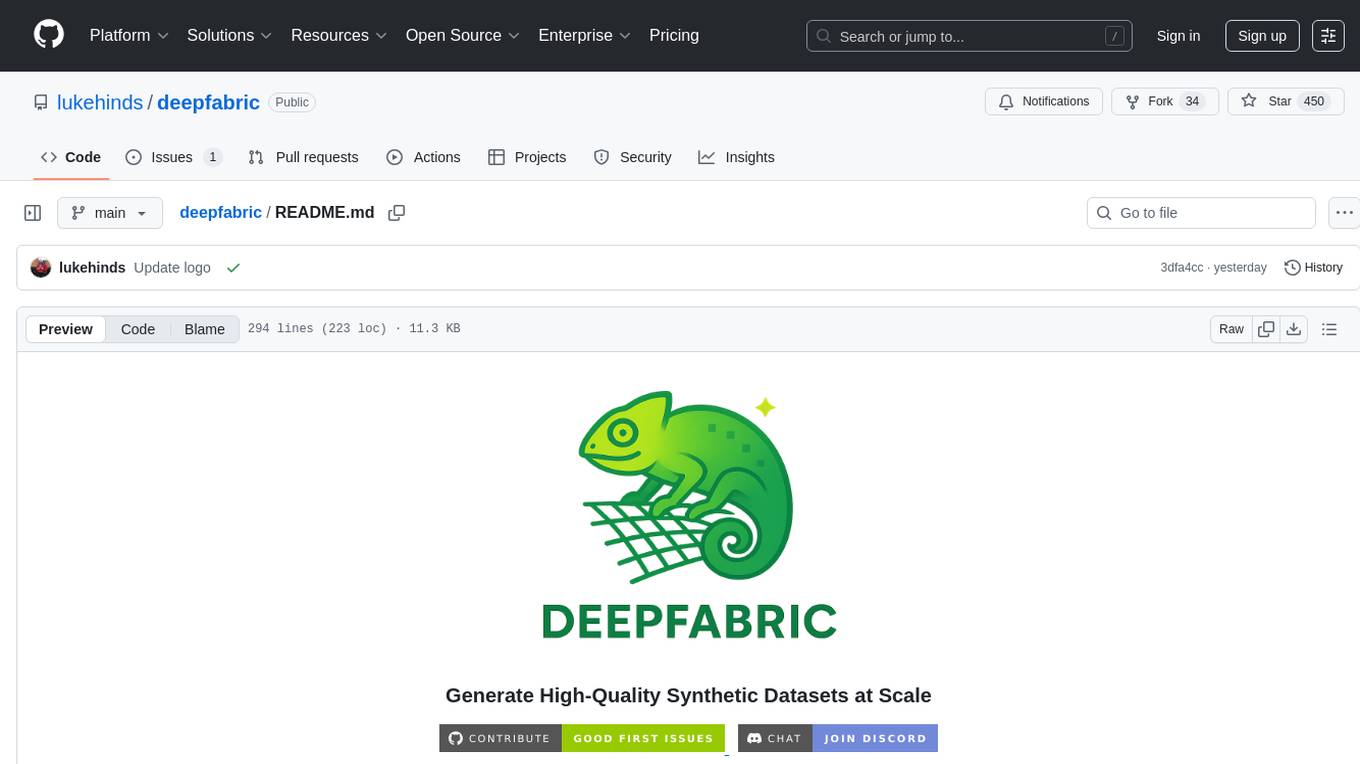
deepfabric
DeepFabric is a CLI tool and SDK designed for researchers and developers to generate high-quality synthetic datasets at scale using large language models. It leverages a graph and tree-based architecture to create diverse and domain-specific datasets while minimizing redundancy. The tool supports generating Chain of Thought datasets for step-by-step reasoning tasks and offers multi-provider support for using different language models. DeepFabric also allows for automatic dataset upload to Hugging Face Hub and uses YAML configuration files for flexibility in dataset generation.
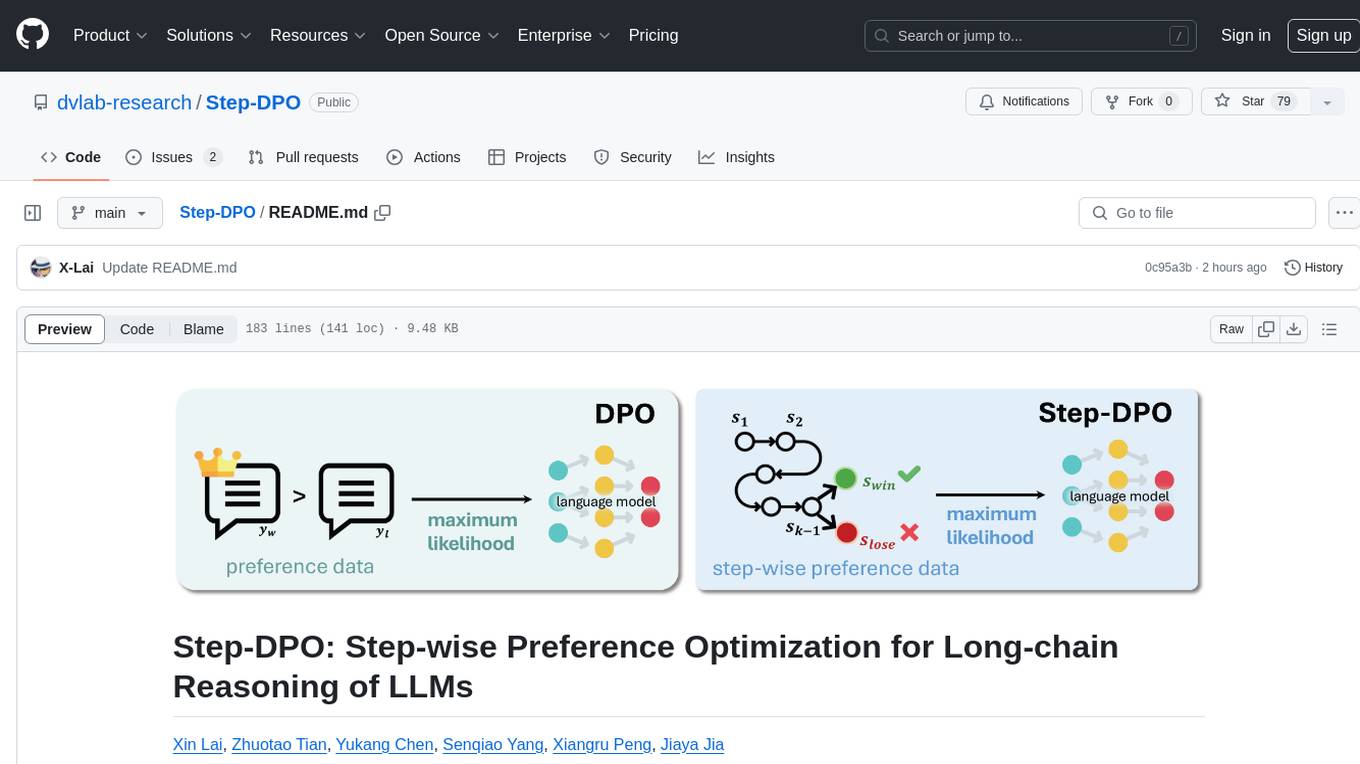
Step-DPO
Step-DPO is a method for enhancing long-chain reasoning ability of LLMs with a data construction pipeline creating a high-quality dataset. It significantly improves performance on math and GSM8K tasks with minimal data and training steps. The tool fine-tunes pre-trained models like Qwen2-7B-Instruct with Step-DPO, achieving superior results compared to other models. It provides scripts for training, evaluation, and deployment, along with examples and acknowledgements.
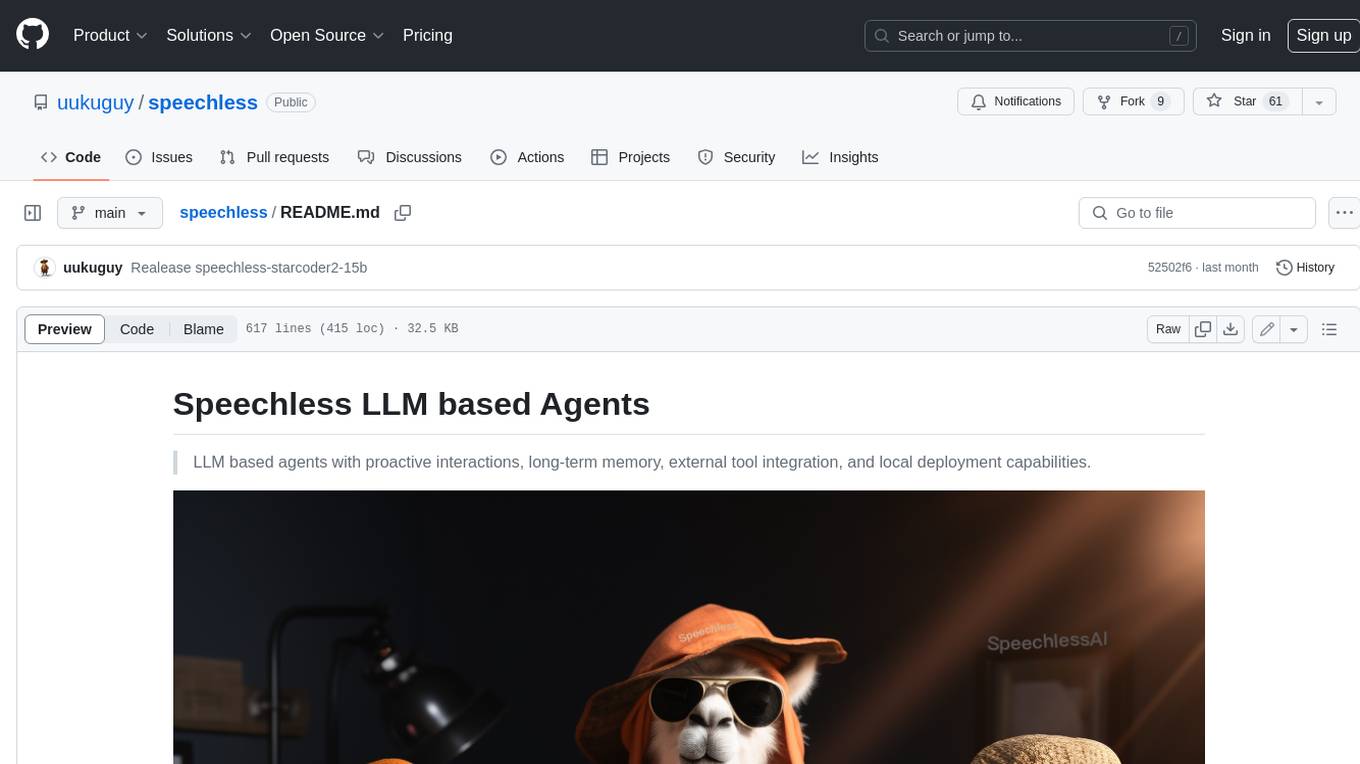
speechless
Speechless.AI is committed to integrating the superior language processing and deep reasoning capabilities of large language models into practical business applications. By enhancing the model's language understanding, knowledge accumulation, and text creation abilities, and introducing long-term memory, external tool integration, and local deployment, our aim is to establish an intelligent collaborative partner that can independently interact, continuously evolve, and closely align with various business scenarios.
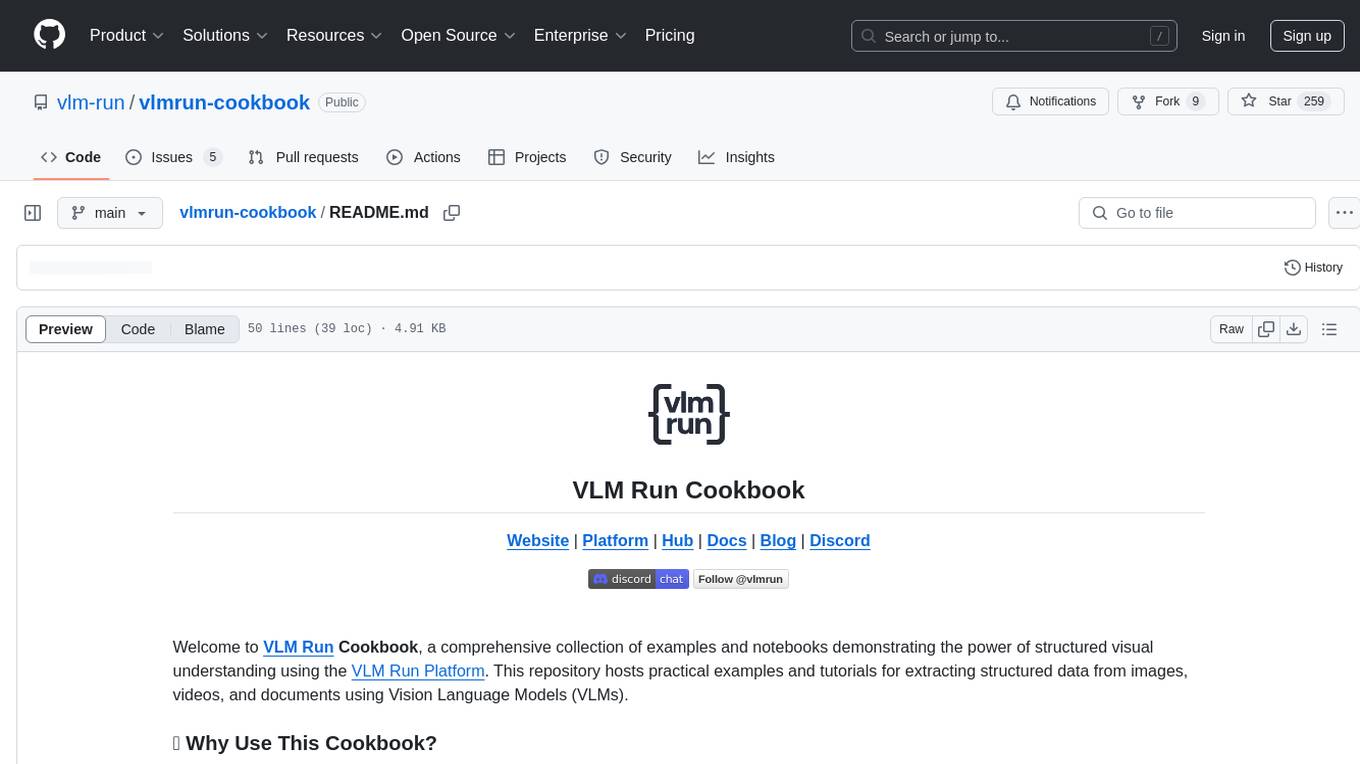
vlmrun-cookbook
VLM Run Cookbook is a repository containing practical examples and tutorials for extracting structured data from images, videos, and documents using Vision Language Models (VLMs). It offers comprehensive Colab notebooks demonstrating real-world applications of VLM Run, with complete code and documentation for easy adaptation. The examples cover various domains such as financial documents and TV news analysis.
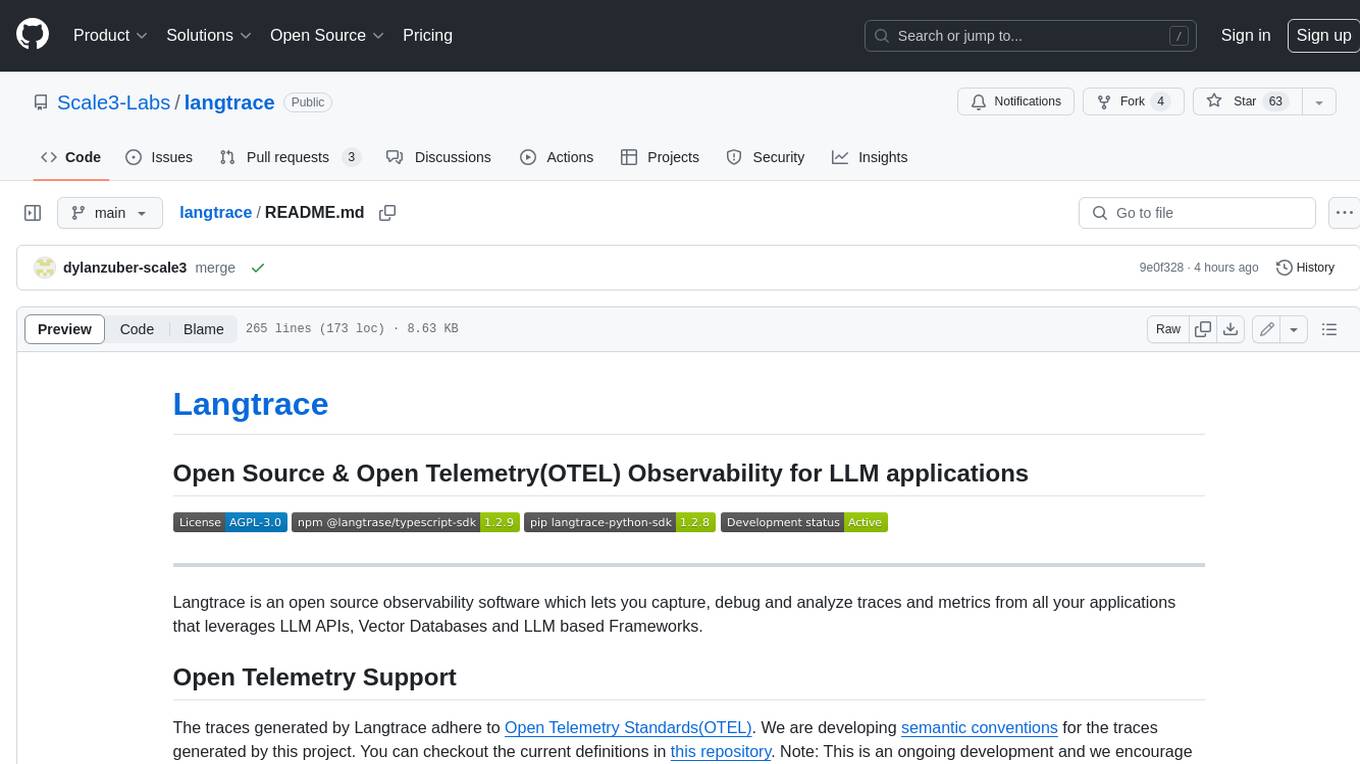
langtrace
Langtrace is an open source observability software that lets you capture, debug, and analyze traces and metrics from all your applications that leverage LLM APIs, Vector Databases, and LLM-based Frameworks. It supports Open Telemetry Standards (OTEL), and the traces generated adhere to these standards. Langtrace offers both a managed SaaS version (Langtrace Cloud) and a self-hosted option. The SDKs for both Typescript/Javascript and Python are available, making it easy to integrate Langtrace into your applications. Langtrace automatically captures traces from various vendors, including OpenAI, Anthropic, Azure OpenAI, Langchain, LlamaIndex, Pinecone, and ChromaDB.
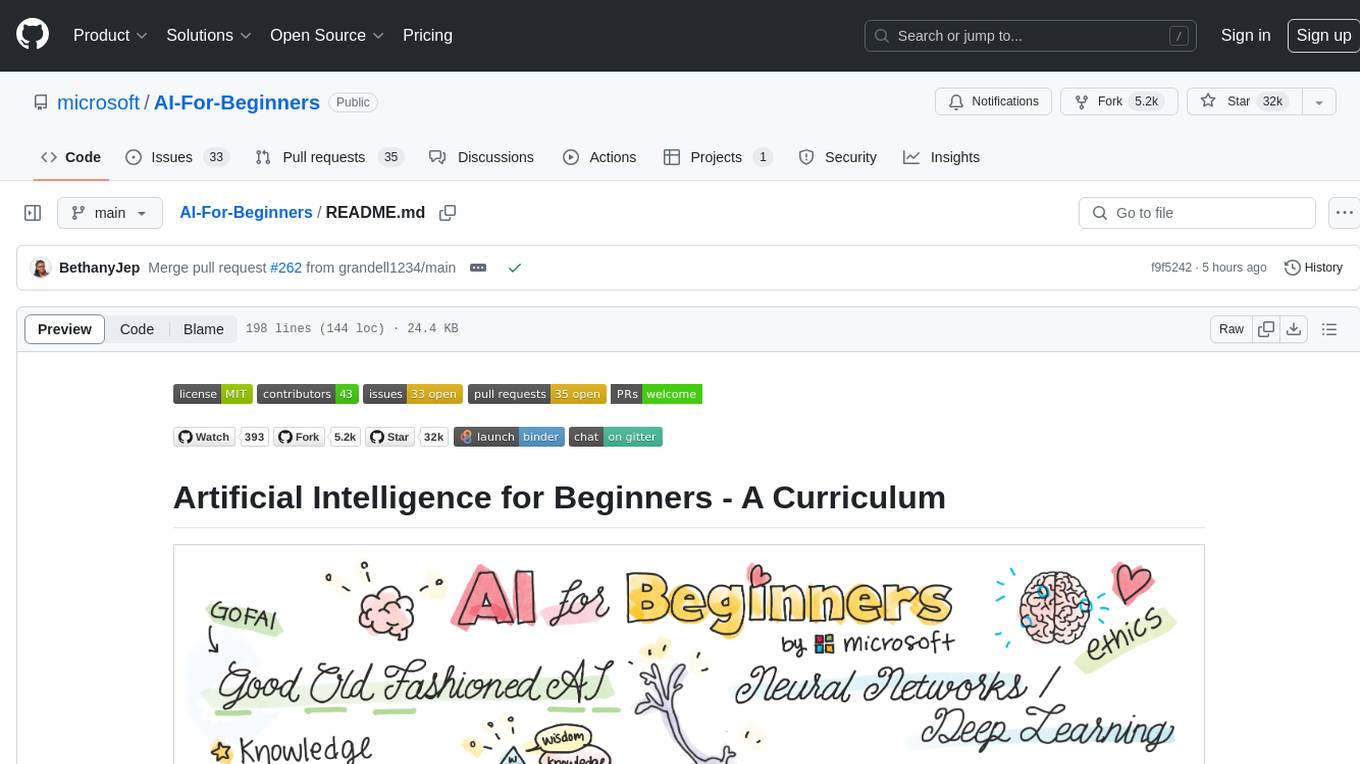
AI-For-Beginners
AI-For-Beginners is a comprehensive 12-week, 24-lesson curriculum designed by experts at Microsoft to introduce beginners to the world of Artificial Intelligence (AI). The curriculum covers various topics such as Symbolic AI, Neural Networks, Computer Vision, Natural Language Processing, Genetic Algorithms, and Multi-Agent Systems. It includes hands-on lessons, quizzes, and labs using popular frameworks like TensorFlow and PyTorch. The focus is on providing a foundational understanding of AI concepts and principles, making it an ideal starting point for individuals interested in AI.
For similar tasks

Azure-Analytics-and-AI-Engagement
The Azure-Analytics-and-AI-Engagement repository provides packaged Industry Scenario DREAM Demos with ARM templates (Containing a demo web application, Power BI reports, Synapse resources, AML Notebooks etc.) that can be deployed in a customer’s subscription using the CAPE tool within a matter of few hours. Partners can also deploy DREAM Demos in their own subscriptions using DPoC.
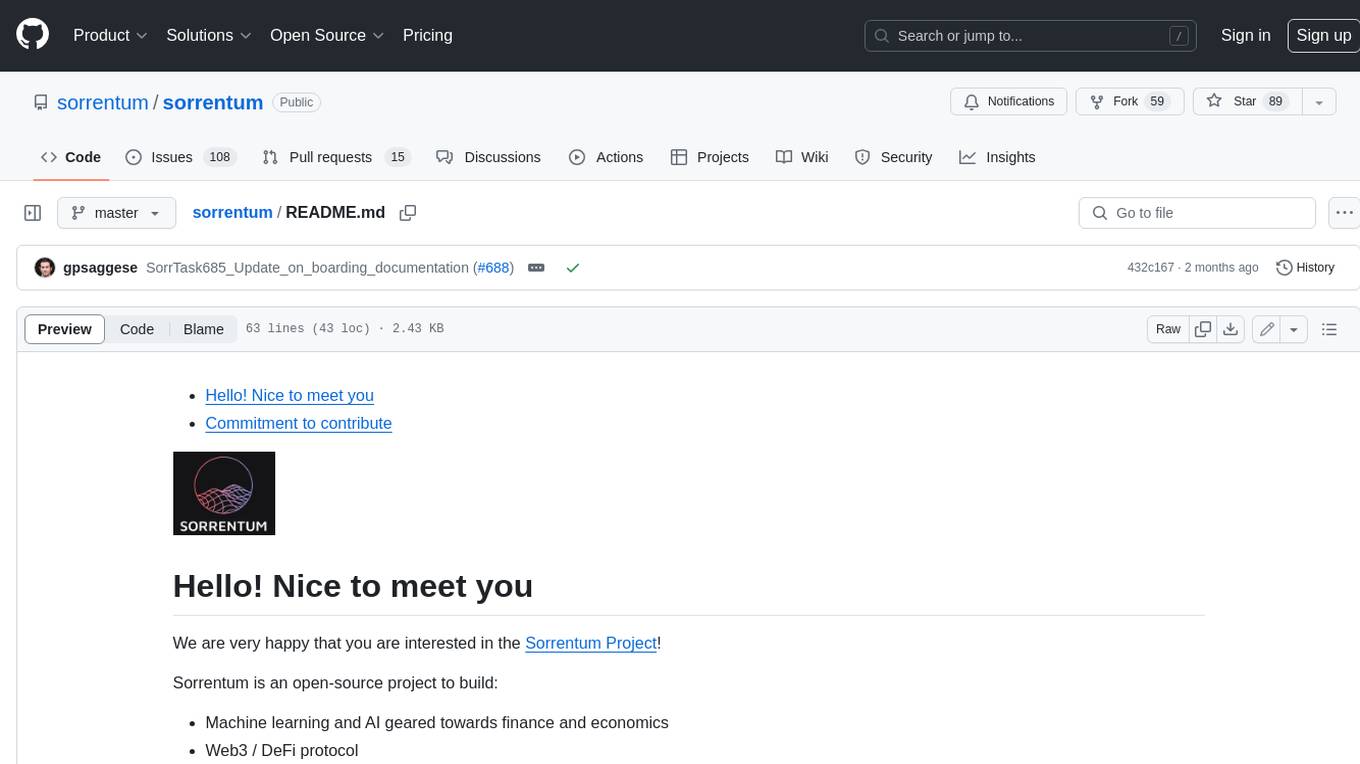
sorrentum
Sorrentum is an open-source project that aims to combine open-source development, startups, and brilliant students to build machine learning, AI, and Web3 / DeFi protocols geared towards finance and economics. The project provides opportunities for internships, research assistantships, and development grants, as well as the chance to work on cutting-edge problems, learn about startups, write academic papers, and get internships and full-time positions at companies working on Sorrentum applications.

tidb
TiDB is an open-source distributed SQL database that supports Hybrid Transactional and Analytical Processing (HTAP) workloads. It is MySQL compatible and features horizontal scalability, strong consistency, and high availability.

zep-python
Zep is an open-source platform for building and deploying large language model (LLM) applications. It provides a suite of tools and services that make it easy to integrate LLMs into your applications, including chat history memory, embedding, vector search, and data enrichment. Zep is designed to be scalable, reliable, and easy to use, making it a great choice for developers who want to build LLM-powered applications quickly and easily.

telemetry-airflow
This repository codifies the Airflow cluster that is deployed at workflow.telemetry.mozilla.org (behind SSO) and commonly referred to as "WTMO" or simply "Airflow". Some links relevant to users and developers of WTMO: * The `dags` directory in this repository contains some custom DAG definitions * Many of the DAGs registered with WTMO don't live in this repository, but are instead generated from ETL task definitions in bigquery-etl * The Data SRE team maintains a WTMO Developer Guide (behind SSO)
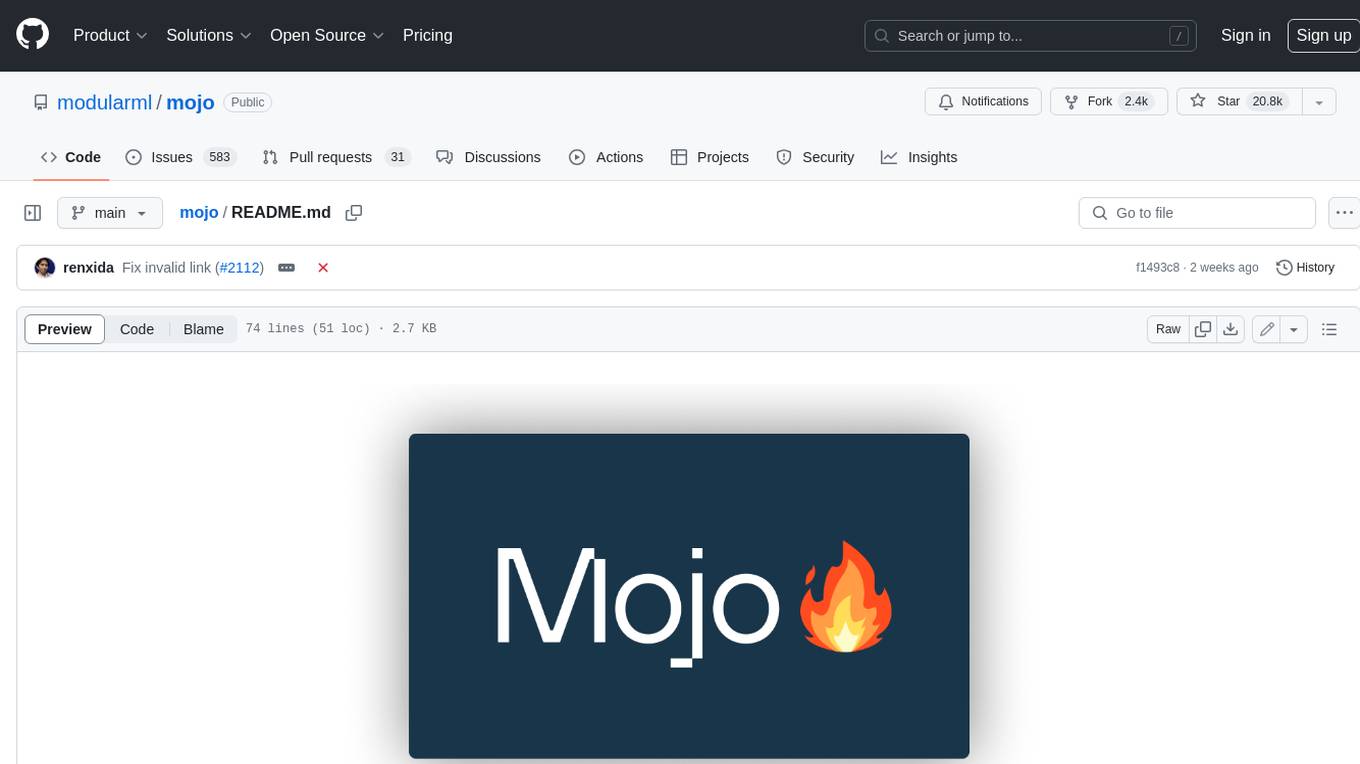
mojo
Mojo is a new programming language that bridges the gap between research and production by combining Python syntax and ecosystem with systems programming and metaprogramming features. Mojo is still young, but it is designed to become a superset of Python over time.
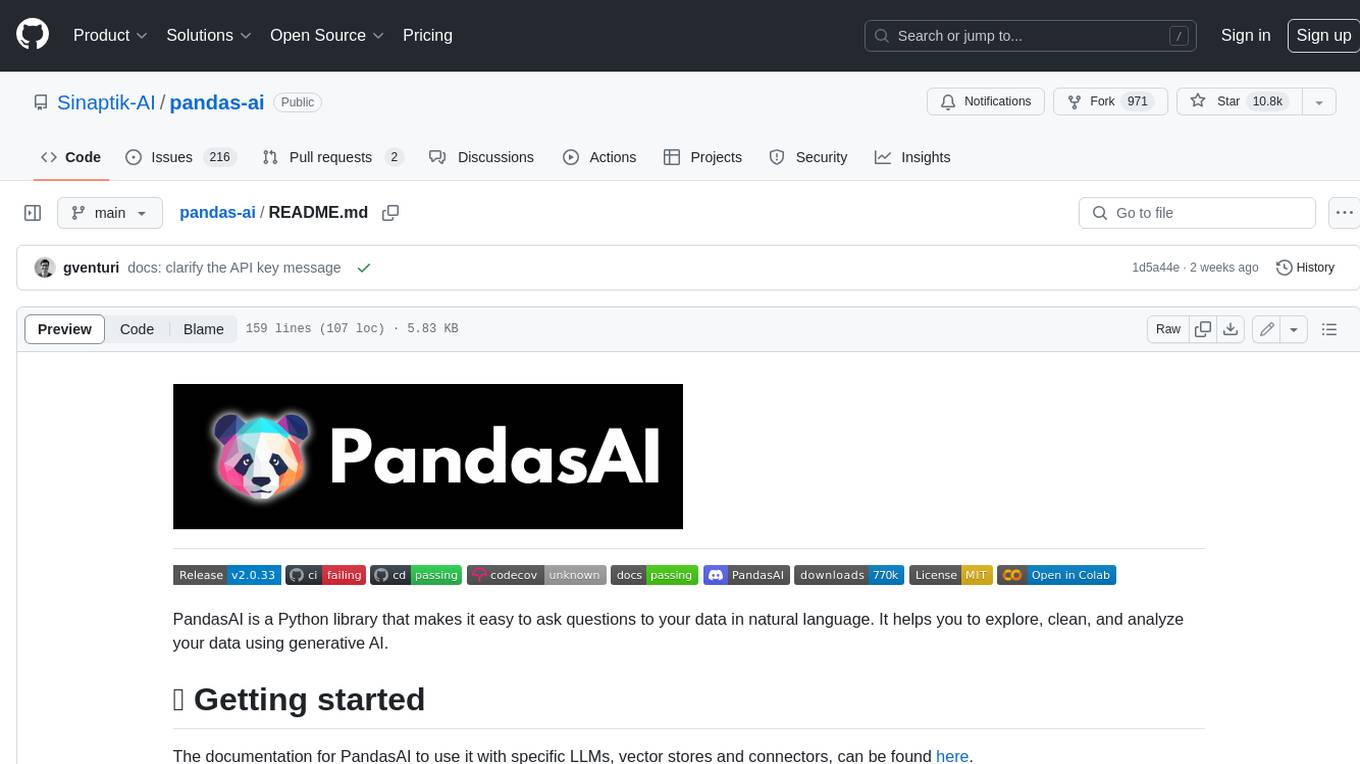
pandas-ai
PandasAI is a Python library that makes it easy to ask questions to your data in natural language. It helps you to explore, clean, and analyze your data using generative AI.

databend
Databend is an open-source cloud data warehouse that serves as a cost-effective alternative to Snowflake. With its focus on fast query execution and data ingestion, it's designed for complex analysis of the world's largest datasets.
For similar jobs

weave
Weave is a toolkit for developing Generative AI applications, built by Weights & Biases. With Weave, you can log and debug language model inputs, outputs, and traces; build rigorous, apples-to-apples evaluations for language model use cases; and organize all the information generated across the LLM workflow, from experimentation to evaluations to production. Weave aims to bring rigor, best-practices, and composability to the inherently experimental process of developing Generative AI software, without introducing cognitive overhead.

LLMStack
LLMStack is a no-code platform for building generative AI agents, workflows, and chatbots. It allows users to connect their own data, internal tools, and GPT-powered models without any coding experience. LLMStack can be deployed to the cloud or on-premise and can be accessed via HTTP API or triggered from Slack or Discord.

VisionCraft
The VisionCraft API is a free API for using over 100 different AI models. From images to sound.

kaito
Kaito is an operator that automates the AI/ML inference model deployment in a Kubernetes cluster. It manages large model files using container images, avoids tuning deployment parameters to fit GPU hardware by providing preset configurations, auto-provisions GPU nodes based on model requirements, and hosts large model images in the public Microsoft Container Registry (MCR) if the license allows. Using Kaito, the workflow of onboarding large AI inference models in Kubernetes is largely simplified.

PyRIT
PyRIT is an open access automation framework designed to empower security professionals and ML engineers to red team foundation models and their applications. It automates AI Red Teaming tasks to allow operators to focus on more complicated and time-consuming tasks and can also identify security harms such as misuse (e.g., malware generation, jailbreaking), and privacy harms (e.g., identity theft). The goal is to allow researchers to have a baseline of how well their model and entire inference pipeline is doing against different harm categories and to be able to compare that baseline to future iterations of their model. This allows them to have empirical data on how well their model is doing today, and detect any degradation of performance based on future improvements.

tabby
Tabby is a self-hosted AI coding assistant, offering an open-source and on-premises alternative to GitHub Copilot. It boasts several key features: * Self-contained, with no need for a DBMS or cloud service. * OpenAPI interface, easy to integrate with existing infrastructure (e.g Cloud IDE). * Supports consumer-grade GPUs.

spear
SPEAR (Simulator for Photorealistic Embodied AI Research) is a powerful tool for training embodied agents. It features 300 unique virtual indoor environments with 2,566 unique rooms and 17,234 unique objects that can be manipulated individually. Each environment is designed by a professional artist and features detailed geometry, photorealistic materials, and a unique floor plan and object layout. SPEAR is implemented as Unreal Engine assets and provides an OpenAI Gym interface for interacting with the environments via Python.

Magick
Magick is a groundbreaking visual AIDE (Artificial Intelligence Development Environment) for no-code data pipelines and multimodal agents. Magick can connect to other services and comes with nodes and templates well-suited for intelligent agents, chatbots, complex reasoning systems and realistic characters.





